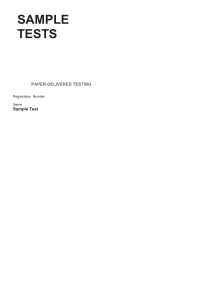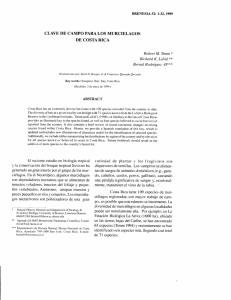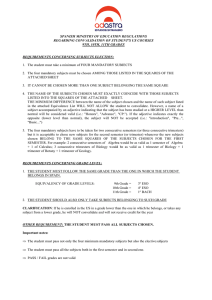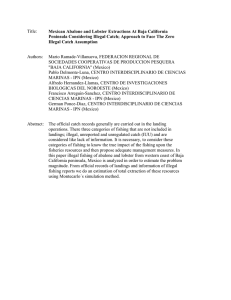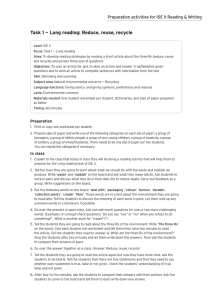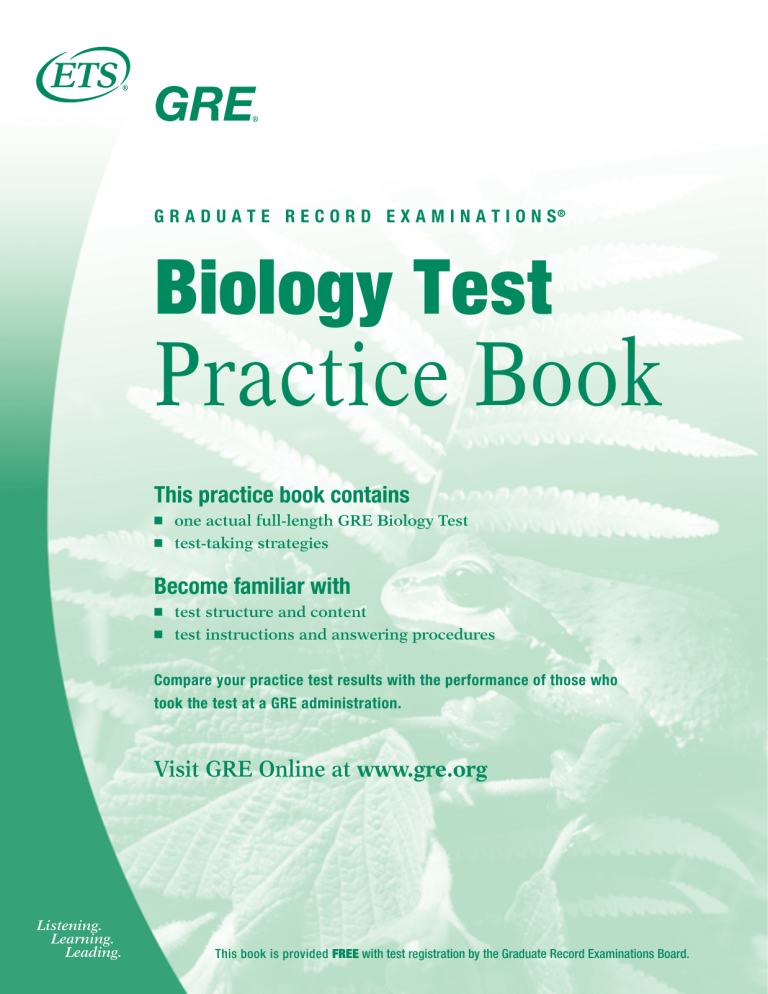
G R A D U A T E R E C O R D E X A M I N A T I O N S® Biology Test Practice Book This practice book contains one actual full-length GRE Biology Test test-taking strategies Become familiar with test structure and content test instructions and answering procedures Compare your practice test results with the performance of those who took the test at a GRE administration. Visit GRE Online at www.gre.org Listening. Learning. Leading. This book is provided FREE with test registration by the Graduate Record Examinations Board. Note to Test Takers: Keep this practice book until you receive your score report. The book contains important information about content specifications and scoring. Copyright © 2001 by Educational Testing Service. All rights reserved. EDUCATIONAL TESTING SERVICE, ETS, the ETS logos, GRADUATE RECORD EXAMINATIONS, and GRE are registered trademarks of Educational Testing Service. Table of Contents Purpose of the GRE Subject Tests ........................ 3 Development of the Subject Tests ....................... 3 Content of the Biology Test ................................. 4 Preparing for a Subject Test ................................. 7 Test-Taking Strategies .......................................... 7 What Your Scores Mean ...................................... 8 Practice Biology Test .......................................... 11 Scoring Your Subject Test .................................. 65 Evaluating Your Performance ............................. 68 Answer Sheet ..................................................... 69 Purpose of the GRE Subject Tests The GRE Subject Tests are designed to help graduate school admission committees and fellowship sponsors assess the qualifications of applicants in specific fields of study. The tests also provide you with an assessment of your own qualifications. Scores on the tests are intended to indicate knowledge of the subject matter emphasized in many undergraduate programs as preparation for graduate study. Because past achievement is usually a good indicator of future performance, the scores are helpful in predicting success in graduate study. Because the tests are standardized, the test scores permit comparison of students from different institutions with different undergraduate programs. For some Subject Tests, subscores are provided in addition to the total score; these subscores indicate the strengths and weaknesses of your preparation, and they may help you plan future studies. The GRE Board recommends that scores on the Subject Tests be considered in conjunction with other relevant information about applicants. Because numerous factors influence success in graduate school, reliance on a single measure to predict success is not advisable. Other indicators of competence typically include undergraduate transcripts showing courses taken and grades earned, letters of recommendation, the GRE Writing Assessment score, and GRE General Test scores. For information about the appropriate use of GRE scores, write to GRE Program, Educational Testing Service, Mail Stop 57-L, Princeton, NJ 08541, or visit our Web site at www.gre.org/codelst.html. Development of the Subject Tests Each new edition of a Subject Test is developed by a committee of examiners composed of professors in the subject who are on undergraduate and graduate faculties in different types of institutions and in different regions of the United States and Canada. In selecting members for each committee, the GRE Program seeks the advice of the appropriate professional associations in the subject. The content and scope of each test are specified and reviewed periodically by the committee of examiners. Test questions are written by the committee and by other faculty who are also subjectmatter specialists and by subject-matter specialists at ETS. All questions proposed for the test are reviewed by the committee and revised as necessary. The accepted questions are assembled into a test in accordance with the content specifications developed by the committee to ensure adequate coverage of the various aspects of the field and, at the same time, to prevent overemphasis on any single topic. The entire test is then reviewed and approved by the committee. BIOLOGY TEST PRACTICE BOOK 3 Subject-matter and measurement specialists on the ETS staff assist the committee, providing information and advice about methods of test construction and helping to prepare the questions and assemble the test. In addition, each test question is reviewed to eliminate language, symbols, or content considered potentially offensive, inappropriate for major subgroups of the test-taking population, or likely to perpetuate any negative attitude that may be conveyed to these subgroups. The test as a whole is also reviewed to ensure that the test questions, where applicable, include an appropriate balance of people in different groups and different roles. Because of the diversity of undergraduate curricula, it is not possible for a single test to cover all the material you may have studied. The examiners, therefore, select questions that test the basic knowledge and skills most important for successful graduate study in the particular field. The committee keeps the test up-to-date by regularly developing new editions and revising existing editions. In this way, the test content changes steadily but gradually, much like most curricula. In addition, curriculum surveys are conducted periodically to ensure that the content of a test reflects what is currently being taught in the undergraduate curriculum. After a new edition of a Subject Test is first administered, examinees’ responses to each test question are analyzed in a variety of ways to determine whether each question functioned as expected. These analyses may reveal that a question is ambiguous, requires knowledge beyond the scope of the test, or is inappropriate for the total group or a particular subgroup of examinees taking the test. Answers to such questions are not used in computing scores. Following this analysis, the new test edition is equated to an existing test edition. In the equating process, statistical methods are used to assess the difficulty of the new test. Then scores are adjusted so that examinees who took a difficult edition of the test are not penalized, and examinees who took an easier edition of the test do not have an advantage. Variations in the number of questions in the different editions of the test are also taken into account in this process. 4 Scores on the Subject Tests are reported as threedigit scaled scores with the third digit always zero. The maximum possible range for all Subject Test total scores is from 200 to 990. The actual range of scores for a particular Subject Test, however, may be smaller. The maximum possible range of Subject Test subscores is 20 to 99; however, the actual range of subscores for any test or test edition may be smaller than 20 to 99. Subject Test score interpretive information is provided in Interpreting Your GRE Scores, which you will receive with your GRE score report, and on the GRE Web site at www.gre.org/codelst.html. Content of the Biology Test The test contains about 200 five-choice questions, a number of which are grouped in sets toward the end of the test and are based on descriptions of laboratory and field situations, diagrams, or experimental results. To cover the broad field of the biological sciences, the subject matter on which the students are tested is organized into three major areas: cellular and molecular biology; organismal biology; and ecology and evolution. Approximately equal weight is given to each of these three areas. However, subject area subdivisions indicated by Arabic numerals may not contain equal numbers of questions. The approximate distribution of questions by content category is shown below. I. Cellular and Molecular Biology 33-34% Fundamentals of cellular biology, genetics, and molecular biology are addressed. Major topics in cellular structure and function include metabolic pathways and their regulation, membrane dynamics, cell surfaces, organelles, cytoskeleton, and cell cycle. Major areas in genetics and molecular biology include chromatin and chromosomal structure, genomic organization and maintenance, and the regulation of gene expression. The cellular basis of immunity, the mechanisms of antigen-antibody interactions, and cell-pathogen interactions are included. Distinctions between prokaryotic and eukaryotic cells are considered where appropriate. Attention is also given to experimental methodology. BIOLOGY TEST PRACTICE BOOK A. Cellular Structure and Function 16-17% 1. Biological compounds Macromolecular structure and bonding Abiotic origin of biological molecules 2. Enzyme activity, receptor binding, and regulation 3. Major metabolic pathways and regulation Respiration, fermentation, and photosynthesis Synthesis and degradation of macromolecules Hormonal control and intracellular messengers 4. Membrane dynamics and cell surfaces Transport, endocytosis, and exocytosis Electrical potentials and neurotransmitters Mechanisms of cell recognition, cell junctions, and plasmodesmata Cell wall and extracellular matrix 5. Organelles: structure, function, and targeting 6. Cytoskeleton, motility, and shape Actin-based systems Microtubule-based systems Intermediate filaments Bacterial flagella and movement 7. Cell cycle, growth, division, and regulation B. Genetics and Molecular Biology 16-17% 1. Genetic foundations Mendelian inheritance; Pedigree analysis Prokaryotic genetics (transformation, transduction, and conjugation) Genetic mapping 2. Chromatin and chromosomes Nucleosomes Karyotypes Chromosomal aberrations Polytene chromosomes 3. Genome sequence organization Introns and exons; Single-copy and repetitive DNA Transposable elements 4. Genome maintenance DNA replication; DNA mutation and repair 5. Gene expression and regulation in prokaryotes and eukaryotes: mechanisms The operon; Promoters and enhancers; Transcription factors; RNA and protein synthesis; Processing and modifications of both RNA and protein 6. Gene expression and regulation: effects Control of normal development; Cancer and oncogenes Signaling mechanisms in cells 7. Immunobiology Cellular basis of immunity; Antibody diversity and synthesis Antigen-antibody interactions 8. Bacteriophages, animal viruses, and plant viruses Viral genomes, replication, and assembly Virus-host cell interactions 9. Recombinant DNA methodology Restriction endonucleases; Blotting and hybridization Restriction fragment length polymorphisms; DNA cloning, sequencing, and analysis; Polymerase chain reaction II. Organismal Biology 33-34% The structure, physiology, behavior, and development of plants and animals are addressed. Topics covered include nutrient procurement and processing, gas exchange, internal transport, regulation of fluids, control mechanisms and effectors, and reproduction in autotrophic and heterotrophic organisms. Examples of developmental phemonena range from fertilization through differentiation and morphogenesis. Perceptions and responses to environmental stimuli are examined as they pertain to both plants and animals. Major distinguishing characteristics and phylogenetic relationships of selected groups from the various kingdoms are also covered. A. Animal Structure, Function, and Organization 9-10% 1. Exchange with environment Nutrient, salt, and water exchange Gas exchange; Energy 2. Internal transport and exchange Circulatory, gastrovascular, and digestive systems 3. Support and movement Support systems (external, internal, and hydrostatic) Movement systems (flagellar, ciliary, and muscular) 4. Integration and control mechanisms Nervous and endocrine systems BIOLOGY TEST PRACTICE BOOK 5 5. Behavior (communication, orientation, learning, and instinct) 6. Metabolic rates (temperature, body size, and activity) B. Animal Reproduction and Development 5-6% 1. Reproductive structures 2. Meiosis, gametogenesis, and fertilization 3. Early development (e.g., polarity, cleavage, and gastrulation) 4. Developmental processes (e.g., induction, determination, differentiation, morphogenesis, and metamorphosis) 5. External control mechanisms (e.g., photoperiod) C. Plant Structure, Function, and Organization, with Emphasis on Flowering Plants 6-7% 1. Tissues, tissue systems, and organs 2. Water transport, including absorption and transpiration 3. Phloem transport and storage 4. Mineral nutrition 5. Plant energetics (e.g., respiration and photosynthesis) D. Plant Reproduction, Growth, and Development, with Emphasis on Flowering Plants 4-5% 1. 2. 3. 4. 5. Reproductive structures Meiosis and sporogenesis Gametogenesis and fertilization Embryogeny and seed development Meristems, growth, morphogenesis, and differentiation 6. Control mechanisms (e.g., hormones, photoperiod, and tropisms) E. Diversity of Life 6-7% 1. Archaebacteria Morphology, physiology, and identification 2. Eubacteria (including cyanobacteria) Morphology, physiology, pathology, and identification 3. Protista Protozoa, other heterotrophic Protista (slime molds and Oomycota), and autotrophic Protista Major distinguishing characteristics Phylogenetic relationships Importance (e.g., eutrophication, disease) 6 4. Fungi Distinctive features of major phyla (vegetative, asexual, and sexual reproduction) Generalized life cycles Importance (e.g., decomposition, biodegradation, antibiotics, and pathogenicity) Lichens 5. Animalia with emphasis on major phyla Major distinguishing characteristics Phylogenetic relationships 6. Plantae with emphasis on major phyla Alternation of generations Major distinguishing characteristics Phylogenetic relationships III. Ecology and Evolution 33-34% This section deals with the interactions of organisms and their environment, emphasizing biological principles at levels above the individual. Ecological and evolutionary topics are given equal weight. Ecological questions range from physiological adaptations to the functioning of ecosystems. Although principles are emphasized, some questions may consider applications to current environmental problems. Questions in evolution range from its genetic foundations through evolutionary processes to their consequences. Evolution is considered at the molecular, individual, population, and higher levels. Principles of ecology, genetics, and evolution are interrelated in many questions. Some questions may require quantitative skills, including the interpretation of simple mathematical models. A. Ecology 16-17% 1. Environment/organism interaction Biogeographic patterns; Adaptations to environment; Temporal patterns 2. Behavioral ecology Habitat selection; Mating systems; Social systems; Resource acquisition 3. Population structure and function Population dynamics/regulation; Demography and life history strategies 4. Communities Interspecific relationships; Community structure and diversity; Change and succession BIOLOGY TEST PRACTICE BOOK 5. Ecosystems Productivity and energy flow; Chemical cycling B. Evolution 16-17% 1. Genetic variability Origins (mutations, linkage, recombination, and chromosomal alterations) Levels (e.g., polymorphism and heritability) Spatial patterns (e.g., clines and ecotypes) Hardy-Weinberg equilibrium 2. Evolutionary processes Gene flow and genetic drift; Natural selection; Levels of selection (e.g., individual and group) 3. Evolutionary consequences Fitness and adaptation; Speciation; Systematics and phylogeny; Convergence, divergence, and extinction 4. History of life Origin of prokaryotic and eukaryotic cells Fossil record Paleontology and paleoecology Test-Taking Strategies The questions in the practice test in this book illustrate the types of multiple-choice questions in the test. When you take the test, you will mark your answers on a separate machine-scorable answer sheet. Total testing time is two hours and fifty minutes; there are no separately timed sections. Following are some general test-taking strategies you may want to consider. Read the test directions carefully, and work as rapidly as you can without being careless. For each question, choose the best answer from the available options. All questions are of equal value; do not waste time pondering individual questions you find extremely difficult or unfamiliar. You may want to work through the test quite rapidly, first answering only the questions about which you feel confident, then going back and answering questions that require more thought, and concluding with the most difficult questions if there is time. Preparing for a Subject Test If you decide to change an answer, make sure you completely erase it and fill in the oval corresponding to your desired answer. GRE Subject Test questions are designed to measure skills and knowledge gained over a long period of time. Although you might increase your scores to some extent through preparation a few weeks or months before you take the test, last minute cramming is unlikely to be of further help. The following information may be helpful. Questions for which you mark no answer or more than one answer are not counted in scoring. A general review of your college courses is probably the best preparation for the test. However, the test covers a broad range of subject matter, and no one is expected to be familiar with the content of every question. Use this practice book to become familiar with the types of questions in the GRE Biology Test, paying special attention to the directions. If you thoroughly understand the directions before you take the test, you will have more time during the test to focus on the questions themselves. As a correction for haphazard guessing, onefourth of the number of questions you answer incorrectly is subtracted from the number of questions you answer correctly. It is improbable that mere guessing will improve your score significantly; it may even lower your score. If, however, you are not certain of the correct answer but have some knowledge of the question and are able to eliminate one or more of the answer choices, your chance of getting the right answer is improved, and it may be to your advantage to answer the question. BIOLOGY TEST PRACTICE BOOK 7 Record all answers on your answer sheet. Answers recorded in your test book will not be counted. Do not wait until the last five minutes of a testing session to record answers on your answer sheet. What Your Scores Mean Your raw score, that is—the number of questions you answered correctly minus one-fourth of the number you answered incorrectly—is converted to the scaled score that is reported. This conversion ensures that a scaled score reported for any edition of a Subject Test is comparable to the same scaled score earned on any other edition of the same test. Thus, equal scaled scores on a particular Subject Test indicate essentially equal levels of performance regardless of the test edition taken. Test scores should be compared only with other scores on the same Subject Test. (For example, a 680 on the Computer Science Test is not equivalent to a 680 on the Mathematics Test.) Before taking the test, you may find it useful to know approximately what raw scores would be required to obtain a certain scaled score. Several factors influence the conversion of your raw score to your scaled score, such as the difficulty of the test edition and the number of test questions included in the computation of your raw score. Based on recent editions of the Biology Test, the following table gives the range of raw scores associated with selected scaled scores for three different test editions. (Note that when the number of scored questions for a given test is greater than the range of possible scaled scores, it is likely that two or more raw scores will convert to the same scaled score.) The three test editions in the table that follows were selected to reflect varying degrees of difficulty. Examinees should note that future test editions may be somewhat more or less difficult than those test editions illustrated in the table. 8 Range of Raw Scores* Needed to Earn Selected Scaled Scores on Three Biology Test Editions That Differ in Difficulty Raw Scores Scaled Score Form A Form B Form C 800 143-145 124-126 118-120 700 113-115 98-99 91-93 600 84-86 71-72 64-66 500 54-56 44-46 37-39 Number of Questions Used to Compute Raw Score 200 198 198 *Raw Score = Number of correct answers minus one-fourth the number of incorrect answers, rounded to the nearest integer. For a particular test edition, there are many ways to earn the same raw score. For example, on the edition listed above as “Form A,” a raw score of 84 through 86 would earn a scaled score of 600. Below are a few of the possible ways in which a scaled score of 600 could be earned on that edition. Examples of Ways to Earn a Scaled Score of 600 on the Edition Labeled as “Form A” Raw Score Questions Answered Correctly Questions Answered Incorrectly Questions Not Answered Number of Questions Used to Compute Raw Score 84 84 0 116 200 84 96 47 57 200 84 107 93 0 200 86 86 0 114 200 86 97 45 58 200 86 108 90 2 200 BIOLOGY TEST PRACTICE BOOK Practice Test To become familiar with how the administration will be conducted at the test center, first remove the answer sheet (pages 69 and 70). Then go to the back cover of the test book (page 64) and follow the instructions for completing the identification areas of the answer sheet. When you are ready to begin the test, note the time and begin marking your answers on the answer sheet. BIOLOGY TEST PRACTICE BOOK 9 FORM GR9924 Unauthorized copying or reuse of any part of this test is illegal. 12 Unauthorized copying or reuse of any part of this test is illegal. 13 Unauthorized copying or reuse of any part of this test is illegal. 14 Unauthorized copying or reuse of any part of this test is illegal. 15 Unauthorized copying or reuse of any part of this test is illegal. 16 Unauthorized copying or reuse of any part of this test is illegal. 17 Unauthorized copying or reuse of any part of this test is illegal. 18 Unauthorized copying or reuse of any part of this test is illegal. 19 Unauthorized copying or reuse of any part of this test is illegal. 20 Unauthorized copying or reuse of any part of this test is illegal. 21 Unauthorized copying or reuse of any part of this test is illegal. 22 Unauthorized copying or reuse of any part of this test is illegal. 23 Unauthorized copying or reuse of any part of this test is illegal. 24 Unauthorized copying or reuse of any part of this test is illegal. 25 Unauthorized copying or reuse of any part of this test is illegal. 26 Unauthorized copying or reuse of any part of this test is illegal. 27 Unauthorized copying or reuse of any part of this test is illegal. 28 Unauthorized copying or reuse of any part of this test is illegal. 29 Unauthorized copying or reuse of any part of this test is illegal. 30 Unauthorized copying or reuse of any part of this test is illegal. 31 Unauthorized copying or reuse of any part of this test is illegal. 32 Unauthorized copying or reuse of any part of this test is illegal. 33 Unauthorized copying or reuse of any part of this test is illegal. 34 Unauthorized copying or reuse of any part of this test is illegal. 35 Unauthorized copying or reuse of any part of this test is illegal. 36 Unauthorized copying or reuse of any part of this test is illegal. 37 Unauthorized copying or reuse of any part of this test is illegal. 38 Unauthorized copying or reuse of any part of this test is illegal. 39 Unauthorized copying or reuse of any part of this test is illegal. 40 Unauthorized copying or reuse of any part of this test is illegal. 41 Unauthorized copying or reuse of any part of this test is illegal. 42 Unauthorized copying or reuse of any part of this test is illegal. 43 Unauthorized copying or reuse of any part of this test is illegal. 44 Unauthorized copying or reuse of any part of this test is illegal. 45 Unauthorized copying or reuse of any part of this test is illegal. 46 Unauthorized copying or reuse of any part of this test is illegal. 47 Unauthorized copying or reuse of any part of this test is illegal. 48 Unauthorized copying or reuse of any part of this test is illegal. 49 Unauthorized copying or reuse of any part of this test is illegal. 50 Unauthorized copying or reuse of any part of this test is illegal. 51 Unauthorized copying or reuse of any part of this test is illegal. 52 Unauthorized copying or reuse of any part of this test is illegal. 53 Unauthorized copying or reuse of any part of this test is illegal. 54 Unauthorized copying or reuse of any part of this test is illegal. 55 Unauthorized copying or reuse of any part of this test is illegal. 56 Unauthorized copying or reuse of any part of this test is illegal. 57 Unauthorized copying or reuse of any part of this test is illegal. 58 Unauthorized copying or reuse of any part of this test is illegal. 59 Unauthorized copying or reuse of any part of this test is illegal. 60 Unauthorized copying or reuse of any part of this test is illegal. 61 Unauthorized copying or reuse of any part of this test is illegal. 62 64 Scoring Your Subject Test Biology Test scores typically range from 490 to 790. The range for different editions of a given test may vary because different editions are not of precisely the same difficulty. The differences in ranges among different editions of a given test, however, usually are small. This should be taken into account, especially when comparing two very high scores. In general, differences between scores at the 99th percentile should be ignored. The score conversion table on page 67 shows the score range for this edition of the test only. Subscores are reported as two-digit scaled scores. The maximum possible range of Subject Test subscores is 20 to 99. Like total scores, the actual range of subscores for any test or test edition may be smaller than 20 to 99. The worksheet on page 66 lists the correct answers to the questions. Columns are provided for you to mark whether you chose the correct (C) answer or an incorrect (I) answer to each question. Draw a line across any question you omitted, because it is not counted in the scoring. At the bottom of the page, enter the total number correct and the total number incorrect. Divide the total incorrect by 4 and subtract the resulting number from the total correct. This is the adjustment made for guessing. Then round the result to the nearest whole number. This will give you your raw total score. Use the total score conversion table to find the scaled total score that corresponds to your raw total score. Example: Suppose you chose the correct answers to 105 questions and incorrect answers to 41. Dividing 41 by 4 yields 10.3. Subtracting 10.3 from 105 equals 94.7, which is rounded to 95. The raw score of 95 corresponds to a scaled score of 630. The subscore columns in the worksheet can be similarly used to tally your correct and incorrect responses to the questions that contribute to each subscore. We suggest that you circle the “•” if you chose the correct answer, and put a minus sign beside the “•” for an incorrect answer. Space is provided at the bottom right of the worksheet to calculate and enter your three raw subscores. The subscore conversion table will show you the scaled subscores that correspond to your raw subscores. BIOLOGY TEST PRACTICE BOOK 65 Worksheet for the Biology Test, Form GR9924 Only Answer Key and Percentages* of Examinees Answering Each Question Correctly QUESTION Number Answer P+ TOTAL C I SUBSCORE 1 2 3 QUESTION Number Answer P+ TOTAL C I SUBSCORE 1 2 3 QUESTION Number Answer P+ TOTAL C I SUBSCORE 1 2 3 1 2 3 4 5 E E B E C 53 60 87 44 83 • • • • • 71 72 73 74 75 D C D E E 37 23 38 20 47 • • • • • 141 142 143 144 145 A D A A E 51 60 67 46 50 6 7 8 9 10 B D A E A 84 36 34 57 75 • • • • • 76 77 78 79 80 D C D C D 28 40 88 69 63 • • • • • 146 147 148 149 150 A C A B B 90 70 84 68 76 11 12 13 14 15 E A A D D 62 32 51 55 25 • • • • • 81 82 83 84 85 A B B D C 73 46 61 54 79 • • • • • 151 152 153 154 155 B C D B B 68 78 71 69 83 16 17 18 19 20 C B C E A 37 38 44 60 44 • • • • • 86 87 88 89 90 B C A A C 90 27 62 78 53 • • • • • 156 157 158 159 160 B D B C A 80 84 32 66 41 21 22 23 24 25 B B D C E 33 31 69 69 23 • • • • • 91 92 93 94 95 A D C D E 75 11 70 58 49 • • • • • 161 162 163 164 165 A E D E B 66 63 68 75 49 26 27 28 29 30 D E C B C 36 26 25 22 27 • • • • • 96 97 98 99 100 A C B D A 90 49 39 51 35 • • • • • 166 167 168 169 170 D B A C B 74 75 68 35 69 • • • • • 31 32 33 34 35 A A B C D 19 78 50 23 49 • • • • • 101 102 103 104 105 E C C C A 40 58 55 51 50 • • • • • 171 172 173 174 175 B C E C C 75 65 62 50 55 • • • • 36 37 38 39 40 D A E A C 34 61 21 43 34 • • • • • 106 107 108 109 110 D C A C D 42 81 76 31 55 • • • • • 176 177 178 179 180 B B C C B 50 38 46 70 74 41 42 43 44 45 E E A C D 34 85 79 41 61 • • • • • 111 112 113 114 115 C E E E A 89 33 65 71 92 • • • • • 181 182 183 184 185 C A B A C 33 58 51 74 53 46 47 48 49 50 D C A C B 43 22 57 83 21 • • • • • 116 117 118 119 120 C C A B A 58 61 83 64 49 • • • 186 187 188 189 190 D D A B C 63 58 47 40 53 51 52 53 54 55 B E A A B 51 81 23 42 59 • • • • • 121 122 123 124 125 E C D C B 67 81 91 76 82 191 192 193 194 195 A A D B B 44 40 53 45 41 56 57 58 59 60 E B A D E 48 63 65 37 25 • • • • • 126 127 128 129 130 D E C D A 66 47 79 31 86 196 197 198 199 200 D B D C B 64 44 47 35 51 61 62 63 64 65 B B D E A 89 28 15 23 43 • • • • • 131 132 133 134 135 C D E A C 29 56 32 63 84 66 67 68 69 70 E B B E D 62 35 26 54 36 • • • • • 136 137 138 139 140 A B C D B 84 81 46 53 45 Correct (C) • • • • • • • • • • • • • • • • • • • • • • • • • • • • • • • • • • • • • • • • • • • • • • • • • • • • • • • • • • • • • • • • • • • • • • • • • Subscores: 1) C – I/4 = ____________ SS = ____________ Incorrect (I) Total Score: 2) C – I/4 = ____________ SS = ____________ 3) C – I/4 = ____________ SS = ____________ C – I/4 = ____________ Scaled Score (SS) = ____________ *The P+ column indicates the percentage of Biology Test examinees that answered each question correctly; it is based on a sample of December 1999 examinees selected to represent all Biology Test examinees tested between October 1, 1997, and September 30, 2000. 66 BIOLOGY TEST PRACTICE BOOK Score Conversions and Percents Below* for GRE Biology Test, Form GR9924 Only Score Conversions for GRE Biology Test Subscores, Form GR9924 Only SUBSCORES TOTAL SCORE Raw Score Scaled Score % Raw Score Scaled Score % 199-200 196-198 193-195 190-192 187-189 184-186 181-183 179-180 176-178 173-175 990 980 970 960 950 940 930 920 910 900 99 99 99 99 99 99 99 99 99 99 81-83 78-80 75-77 72-74 69-71 66-68 63-65 60-62 57-59 54-56 590 580 570 560 550 540 530 520 510 500 37 33 31 27 25 22 19 17 15 12 170-172 167-169 164-166 161-163 158-160 155-157 152-154 149-151 146-148 143-145 890 880 870 860 850 840 830 820 810 800 99 98 98 98 97 96 95 94 93 92 51-53 48-50 45-47 42-44 39-41 36-38 33-35 30-32 28-29 25-27 490 480 470 460 450 440 430 420 410 400 10 8 7 6 5 4 3 2 2 1 140-142 137-139 134-136 131-133 128-130 125-127 122-124 119-121 116-118 113-115 790 780 770 760 750 740 730 720 710 700 91 89 87 85 84 81 79 76 74 71 22-24 19-21 16-18 13-15 10-12 7-9 4-6 1-3 0 390 380 370 360 350 340 330 320 310 1 1 1 1 1 1 1 1 1 110-112 107-109 105-106 102-104 99-101 96-98 93-95 90-92 87-89 84-86 690 680 670 660 650 640 630 620 610 600 69 66 63 60 56 53 50 47 43 40 Raw Score Sub 1 Sub 2 Sub 3 Scaled Score Sub 1 62-65 61 60 59 58 57 56 55 54 68 66-67 99 98 97 96 95 94 93 92 91 90 26 25 24 22-23 21 20 19 18 16-17 15 23 22 21 20 19 18 17 16 15 31 29-30 28 27 26 25 24 23 21-22 20 59 58 57 56 55 54 53 52 51 50 67 66 65 64 62-63 Raw Score Sub 2 Sub 3 Scaled Score 61 60 59 58 56-57 55 54 53 52 51 53 52 51 50 49 48 47 46 45 44 65 64 63 62 61 59-60 58 57 56 55 89 88 87 86 85 84 83 82 81 80 14 13 12 11 9-10 8 7 6 5 3-4 14 13 12 11 10 9 8 7 6 5 19 18 17 16 14-15 13 12 11 10 9 49 48 47 46 45 44 43 42 41 40 49-50 48 47 46 45 44 42-43 41 40 39 43 42 41 40 39 38 37 36 35 34 54 53 51-52 50 49 48 47 46 44-45 43 79 78 77 76 75 74 73 72 71 70 2 1 0 4 3 2 1 0 8 6-7 5 4 3 2 1 0 39 38 37 36 35 34 33 32 38 36-37 35 34 33 32 31 29-30 28 27 33 32 31 30 29 28 27 26 25 24 42 41 40 39 38 36-37 35 34 33 32 69 68 67 66 65 64 63 62 61 60 *Percentage scoring below the scaled score is based on the performance of 19,924 examinees who took the Biology Test between October 1, 1997, and September 30, 2000. BIOLOGY TEST PRACTICE BOOK 67 Evaluating Your Performance Now that you have scored your test, you may wish to compare your performance with the performance of others who took this test. Both the worksheet on page 66 and the tables on page 67 use performance data from GRE Biology Test examinees. The data in the worksheet on page 66 are based on the performance of a sample of the examinees who took this test in December 1999. This sample was selected to represent the total population of GRE Biology Test examinees tested between October 1997 and September 2000. The numbers in the column labeled “P+” on the worksheet indicate the percentages of examinees in this sample who answered each question correctly. You may use these numbers as a guide for evaluating your performance on each test question. The first table on page 67 contains, for each scaled score, the percentage of examinees tested between October 1997 and September 2000 who received lower scores. Interpretive data based on the scores earned by examinees tested in this three-year period will be used by admissions officers in the 2001-02 testing year. These percentages appear in the score conversion table in a column to the right of the scaled scores. For example, in the percentage column opposite the scaled score of 630 is the number 50. This means that 50 percent of the GRE Biology Test examinees tested between October 1997 and September 2000 scored lower than 630. To compare yourself with this population, look at the percentage next to the scaled score you earned on the practice test. 68 Your three subscores show your relative strengths or weaknesses in the three subfield areas of the GRE Biology Test. The raw subscores are scaled in such a way that they are related to the total scores on the test. On the average, a person who has a comprehensive background in the field can expect to have subscores equal to about one-tenth of his or her total score. Thus, if you have a total score of 600, and your undergraduate program placed equal emphasis on the three areas of Biology represented by the subscores, you would expect to have a scaled subscore of about 60 in each area. If, however, your subscores differ by more than a few points, you may take this as an indication that your lower score shows weakness, and you may wish to concentrate your review efforts on topics in that area. It is important to realize that the conditions under which you tested yourself were not exactly the same as those you will encounter at a test center. It is impossible to predict how different test-taking conditions will affect test performance, and this is only one factor that may account for differences between your practice test scores and your actual test scores. By comparing your performance on this practice test with the performance of other GRE Biology Test examinees, however, you will be able to determine your strengths and weaknesses and can then plan a program of study to prepare yourself for taking the GRE Biology Test under standard conditions. BIOLOGY TEST PRACTICE BOOK ® 00101-007629 • WEBPDF116 727016
